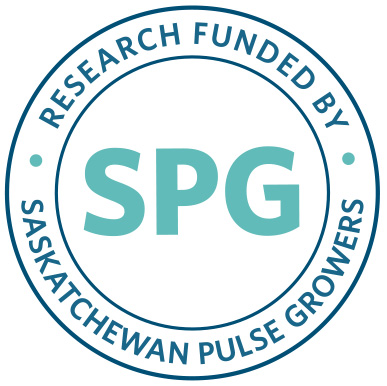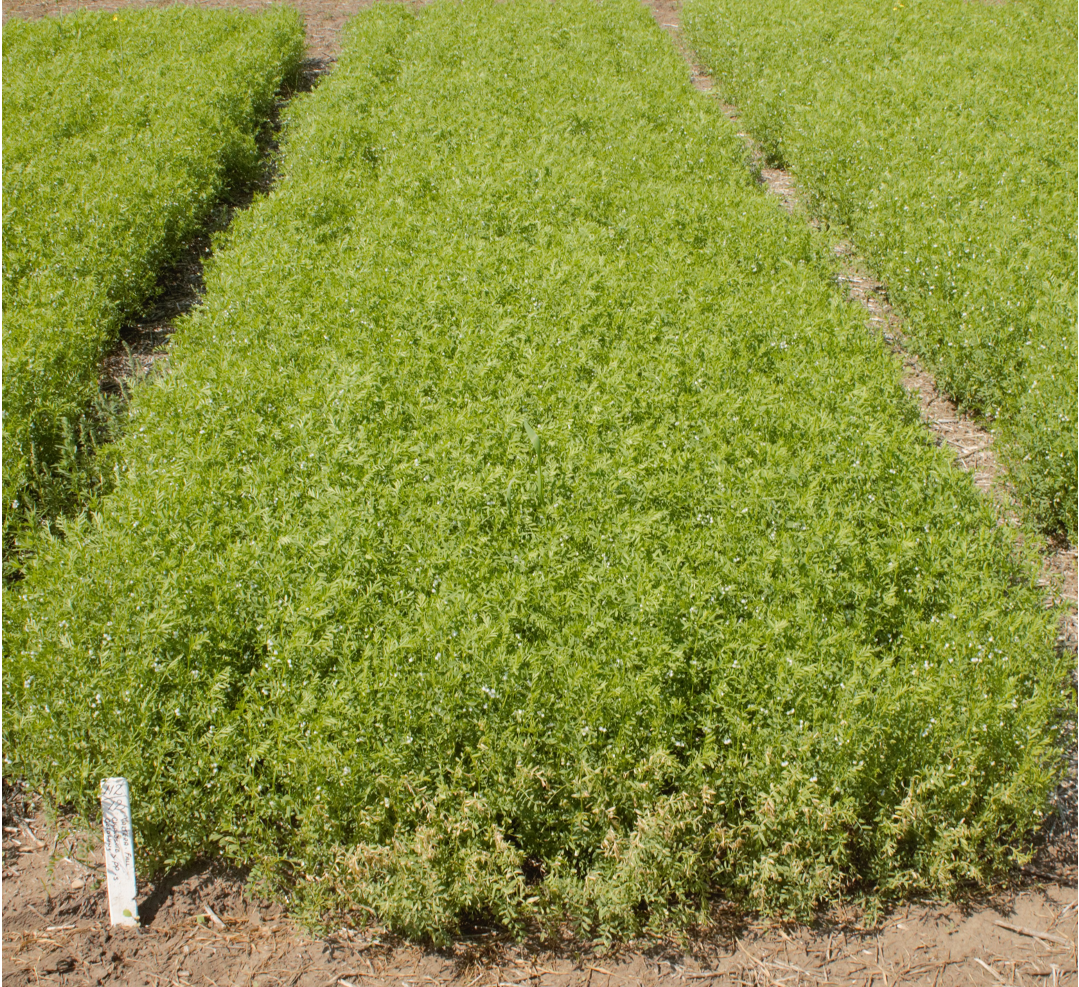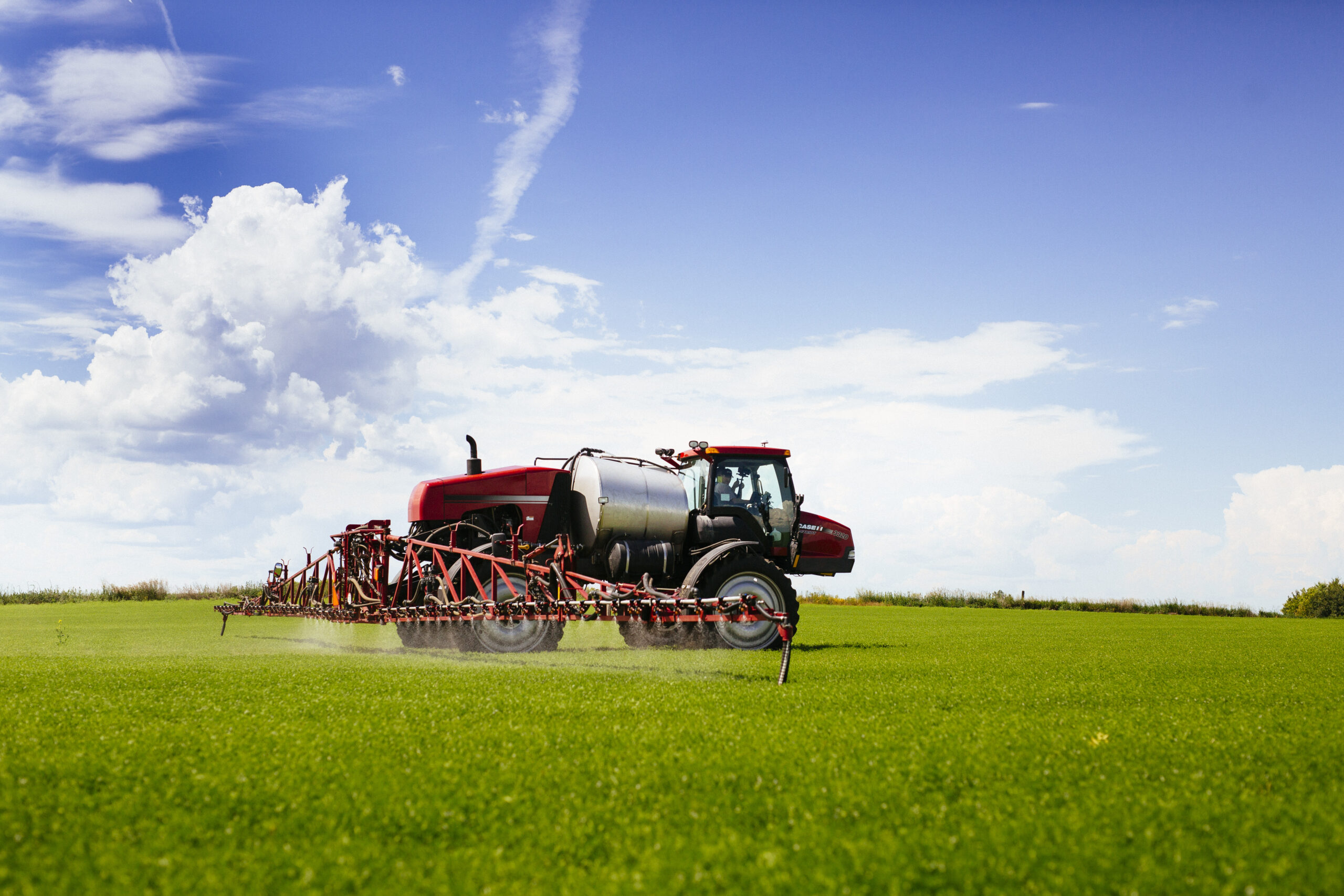Research collaborators: Jessica Enns, Chris Willenborg, Dilshan DeSilva Benaragama, Lana Shaw, and Bryan Nybo
Summary prepared by Alexis Adams, MSc, PAg
Introduction
Weed control is one of the main challenges Saskatchewan lentil growers face due to the poor competitive ability of lentils and the rise of herbicide resistant weeds. Typical basic weed control methods for lentils include a non-selective group 9 pre-seed burn off followed by an in-crop group 2 herbicide application. Group 2 resistant wild mustard and group 2, 4, and/or 9 resistant kochia are rendering this weed management system ineffective. Thankfully, other herbicide options exist to combat weed resistance in lentils including spring applied glyphosate tank mix partners and fall or spring applied residual herbicides. To compare and demonstrate these lentil weed control strategies, Saskatchewan Pulse Growers (SPG) funded a demonstration project across four sites in the 2020 growing season. The objectives of the project were to demonstrate: 1) weed control options for kochia, wild mustard, and volunteer canola; 2) lentil herbicide layering strategies; and 3) the value of planning ahead with application of a fall applied residual herbicide. The overarching aim of this demonstration project was to show lentil producers the benefits of herbicide layering with multiple modes of action for both in season weed control and herbicide resistance management.
Key Messages
- Application of herbicides in the spring only was not an effective form of wild mustard, kochia, or volunteer canola control for lentils, even when glyphosate was tank mixed with Heat® or Goldwing®.
- The Solo® in crop only treatment had little to no phytotoxic impact on any weeds present at any research sites.
- Wild mustard was best controlled by:
- Fall applied Focus® with spring applied Heat® + glyphosate, or
- Fall applied Fierce® with spring applied glyphosate + Goldwing®
- Kochia control was highest with:
- Fall applied Valtera™ and spring glyphosate
- Fall applied Fierce® and spring glyphosate, or
- Fall applied Fierce® with spring glyphosate + Goldwing®
- Volunteer canola was most impacted by:
- Fall applied Valtera™ and spring glyphosate
- Fall applied Valtera™ and spring glyphosate + Goldwing®, or
- Fall applied Fierce® with spring glyphosate + Goldwing®
- Fierce® applied in the fall followed by Goldwing® + glyphosate in the spring had the best activity on all weeds assessed.
- While the above listed treatments delivered the best weed control results, other treatments that also involved a soil residual herbicide and spring burnoff provided good weed control indicating there are multiple good lentil herbicide layering options available for growers to rotate between.
- From this study, herbicide layering, including a fall applied residual herbicide, spring burnoff, and in crop herbicide, is recommended for optimal weed control and resistance management in lentils
Research Methodology
Site Management and Treatment Descriptions
The demonstration project was conducted at four sites across Saskatchewan: Saskatoon, Scott, Swift Current, and Redvers.
Sixteen herbicide treatments of varying herbicide combinations and application timings were used. See Table 1 for treatments and Table 2 for the active names, herbicide groups, rates, and concentrations of each product used. Each treatment was replicated four times. Adjuvants were applied with products as required. Merge at 2 L ac-1 (litres per acre) was used with Heat LQ® and Zidua SC®, and Fierce®, Focus®, and Valtera™ were mixed with Agral 90 or Ag Surf at 0.25% v/v when not applied with glyphosate. See Table 3 for the treatment dates for fall applied herbicide, spring pre-seed burndown and in-crop herbicide application as well as seeding date at each site. Lentils were sown into canola stubble at each site. The plots were cross seeded with kochia at Scott, Saskatoon, and Swift Current and canola at all four sites. Clearfield mustard was used at Scott, Saskatoon, and Redvers to simulate group 2 resistant wild mustard, and wild mustard was sown at Saskatoon. A natural weed strip was also left in each plot. CDC Impulse (small red) lentils were seeded at 3 cm (1.18 inch) depth targeting 180 plants m2 (17 plants ft2). Seed was treated with Vibrance® Maxx + Intego® and granular inoculant was used.
Table 1. Herbicide Treatments
| Treatment Number | Treatment | Timing | Treatment Abbreviation |
|---|---|---|---|
| 1 | In crop Solo® | In crop | C-Solo |
| 2 | Glyphosate | Spring | Sp-Gly |
| 3 | Glyphosate | Spring | Sp-Gly+Ht |
| Heat LQ® | Spring | ||
| 4 | Glyphosate | Spring | Sp-Gly+Gol |
| Goldwing® | Spring | ||
| 5 | Edge® | Fall | F-Edge/Sp-Gly |
| Glyphosate | Spring | ||
| 6 | Edge® | Fall | F-Edge+Ht/Sp-Gly |
| Heat LQ® | Fall | ||
| Glyphosate | Spring | ||
| 7 | Focus® | Fall | F-Foc+Exp/Sp-Gly |
| Express SG | Fall | ||
| Glyphosate | Spring | ||
| 8 | Focus® | Fall | F-Foc/Sp-Gly |
| Glyphosate | Spring | ||
| 9 | Focus® | Fall | F-Foc/Sp-Ht+Gly |
| Heat LQ® | Spring | ||
| Glyphosate | Spring | ||
| 10 | Focus® | Spring | Sp-Foc+Gly |
| Glyphosate | Spring | ||
| 11 | Valtera EZ™️ | Fall | F-Val/Sp-Gly |
| Glyphosate | Spring | ||
| 12 | Valtera EZ™️ | Fall | F-Val/Sp-Gol+Gly |
| Goldwing® | Spring | ||
| Glyphosate | Spring | ||
| 13 | Fierce® | Fall | F-Fie/Sp-Gly |
| Glyphosate | Spring | ||
| 14 | Fierce® | Fall | F-Fie/Sp-Gol+Gly |
| Goldwing® | Spring | ||
| Glyphosate | Spring | ||
| 15 | Heat LQ® | Spring | Sp-Ht+Zid |
| Zidua SC® | Spring | ||
| 16 | Edge® | Fall | F-Edg/Sp-Ht+Zid |
| Heat LQ® | Spring | ||
| Zidua SC® | Spring |
Table 2. Active names, herbicide groups, rates, and concentrations for products used in treatments
| Product | Active(s) | Group(s) | Rate | Concentration (g/L) | Rate (g ai/ha) |
|---|---|---|---|---|---|
| Heat LQ® | Saflufenacil | 14 | 21.4 mL/ac | 342 | 18.1 |
| Goldwing® | Pyraflufen-ethyl, MCPA | 14, 4 | 133 mL/ac | 433.5 | 142.4 |
| Edge® | Ethalfluralin | 3 | 19.6 lb/ac[1] | 1100 | |
| Focus® | Carfentrazone-ethyl, pyroxasulfone | 14, 15 | 113 mL/ac to 136 mL/ac[2] | 500 | 139.6 to 168.0 |
| Express® SG | Tribenuron | 2 | 6 g/ac | 50% | 7.5 |
| Valtera™️ | Flumioxazin | 14 | 90 mL/ac | 480 | 106.7 |
| Fierce® | Flumioxazin, pyroxasulfone | 14, 15 | 85 g/ac | 76% | 159.6 |
| Zidua® | Pyroxasulfone | 15 | 49 mL/ac | 500 | 60.5 |
| Glyphosate | Glyphosate | 9 | 0.67 L/ac | 540 | 893.6 |
| Solo® | Imazamox | 2 | 15 |
Table 3. Timing of crop management practices by site
| Crop Management | Saskatoon | Scott | Swift Current | Redvers |
|---|---|---|---|---|
| Fall herbicide application | 28-Oct-19 | 21-Oct-19 | 17-Oct-19 | 21-Oct-19 |
| Pre-plant herbicide application | 13-May-20 | 13-May-20 | 05-May-20 | 15-May-20 |
| Seeding | 14-May-20 | 14-May-20 | 08-May-20 | 16-May-20 |
| In-crop application | 15-Jun-20 | 15-Jun-20 | 08-Jun-20 | 13-Jun-20 |
Weed and crop assessments
Weed control efficacy between treatments was assessed at 7–14 (early), 21–28 (middle), and 56 (late) days after emergence (DAE). Assessments were made visually using the Canadian Weed Science Society (CWSS) 0–100% scale. Values above 80% indicate adequate control. Mustard, canola, and kochia were assessed for phytotoxicity at Saskatoon and Scott, whereas only mustard was assessed at Swift Current. The normally occurring weed population was also assessed for phytotoxicity at Saskatoon, Scott, and Swift Current. There was no phytotoxicity assessment at Redvers due to low weed density.
At Saskatoon and Scott, lentil plants were also assessed visually at the early, middle, and late season stages for phytotoxicity symptoms based on the CWSS scale, with 0% indicating no herbicide injury and 100% indicating complete mortality. Phytotoxicity below 15% is considered an acceptable rating for lentil plants. Yield was also considered when comparing treatments. Plots were harvested by a small plot combine and yields were adjusted to 14% moisture content. Final yield was determined after cleaning and weighing lentil samples.
Results
Climate
In the 2020 growing season, temperature variations between sites were small, however, precipitation totals varied to a greater degree. See Figure 1 for mean temperature (°C) and Figure 2 for total precipitation (mm). Rainfall is an important factor in the activation of soil residual herbicides. The rainfall received would most likely have been enough to activate the residual herbicides at all sites. Scott received the largest amount of total rainfall, at 274 mm, followed by Saskatoon at 205 mm, Swift Current at 185 mm, and Redvers with 166 mm. Saskatoon, Swift Current, and Redvers received the bulk of precipitation in June, whereas most of the rain at Scott was received in July. Rainfall was lowest at all sites in August, but especially low at Swift Current.


Crop Phytotoxicity
Crop phytotoxicity was only assessed at Saskatoon and Scott sites. Treatment 1, (in-crop Solo®), had the lowest phytotoxicity at both sites, which was 1% at Saskatoon and Scott at 7–14 DAE (Figure 3). The treatments with the highest crop phytotoxicity at Saskatoon were treatment 6 (F-Edge+Ht/Sp-gly) and treatment 12 (F-Val/Sp-Gly+Gol), which were both at 14% at 7–14 DAE. Treatment 6 dropped to 9% and Treatment 12 dropped to 4% at 56 DAE. Phytotoxicity ratings were lower overall at Scott. Similar to Saskatoon, treatment 12 (F-Val/Sp-Gly+Gol) had the highest level of phytotoxicity at 8% and 4% at 7–14 and 56 DAE respectively (Figure 4). All treatments at both sites were at an acceptable phytotoxicity level of below 15% at 7–14 DAE and all treatments were below 5% at 56 DAE, except for treatment 6 at Saskatoon, indicating these treatments can be used in lentils with little risk to the crop.


Weed Phytotoxicity
Wild mustard, kochia, volunteer canola, and the normally existing weeds at each site were assessed for phytotoxicity from the herbicide treatments. Statistical analysis showed a treatment/site interaction for each weed at each stage assessed (7–14, 21–28, and 56 DAE). This interaction indicates that the treatments varied in phytotoxicity depending on the site.
i. Wild Mustard Phytotoxicity
Wild mustard phytotoxicity was assessed at Saskatoon, Scott, and Swift Current. At Saskatoon, treatments 2 to 16 had above 80% control of wild mustard in the early season assessment, however in the middle and late season assessments, treatments 9 (F-Foc/Sp-Ht+Gly) and 14 (F-Fie/Sp-Gol+Gly) distinguished as the products with the best residual weed activity (Figure 5). Treatments 1 (Solo®), 2 (Sp-Gly), 5 (F-Edge/ Sp-Gly), 11 (F-Val+Gly), and 16 (F-Edge/Sp-Ht+Zid) had the lowest mustard phytotoxicity in the middle and late season assessments.
At Scott, ten of sixteen treatments remained above 80% for mustard phytotoxicity throughout the season (Figure 6). Treatments 1 (Solo®), 2 (Sp-Gly), 3 (Sp-Gly+Ht), 5 (F-Edge/Sp- Gly), 7 (F-Foc+Exp/Sp-Gly), and 8 (F-Foc/Sp-Gly) were rated below 80% throughout the growing season.
At Swift Current, treatments 9 (F-Foc/Sp-Ht+Gly), 12 (F-Val/ Sp-Gol+Gly), 13 (F-Fie/Sp-Gly), 14 (F-Fie/Sp-Gol+Gly), and 16 (F-Edge/Sp-Ht+Zid) had a mustard phytotoxicity response above 80% at both the early and mid-season assessments (Figure 7). Treatments 6 (F-Edge+Ht/Sp-Gly) and 11 (F-Val+Gly) were also above 80% in the mid-season assessment. All treatments were below 60% in the late season assessment, with the highest phytotoxicity response from treatments 13 and 14. Treatments 1–5, 7, 10 and 15 had the lowest phytotoxicity rating throughout the season.
Across all three sites, treatments 9 (F-Foc/Sp-Ht+Gly) and 14 (F-Fie/Sp-Gol+Gly) had high levels of activity on wild mustard. Treatments that consistently showed the lowest phytotoxicity levels across all three sites were treatments 1 (Solo®), 2 (Sp- Gly), and 5 (F-Edge/Sp-Gly).
ii. Kochia Phytotoxicity
Kochia phytotoxicity was assessed at Saskatoon and Scott. At Saskatoon, in the early season kochia phytotoxicity in all treatments except treatment 1 (Solo®) and 2 (Sp-Gly) were above 80%, with treatment 2 just below 80% (Figure 8). In the mid-season, treatments 1 to 4 were below 60%, and treatments 12 (F-Val/Sp-Gol+Gly), 13 (F-Fie/Sp-Gly), and 16 (F-Edg/Sp-ht+Zid) were highest at above 80%. In the late season, most treatments were around 70% phytotoxicity, except 1, 2, and 5 (F-Edge/Sp-Gly), which were below 40% control.
In the early season at Scott, kochia phytotoxicity for treatments 4 to 16 were close to 90%, with treatment 3 (Sp-Gly+Ht) just below 80% (Figure 9). Treatment 2 was 60% and treatment 1 had no phytotoxicity on kochia. In the mid-season, all treatments were below 80% except for 3 and 11 (F-Val/Sp- Gly). Treatments 1, 8, 10, 14 and 16 had the lowest phytotoxicity ratings. In the late season, treatments 1 to 4 showed the lowest levels of control.
The treatments that were consistently low at both sites were the control (in-crop Solo®), as well as the spring only treatments without residual, which included treatments 2 (Sp-Gly), 3 (Sp- Gly+Ht), and 4 (Sp-Gly+Gol). Treatments 6 to 16 all had good activity on kochia, with some variability, with treatments 11 (F-Val/Sp-Gly), 13 (F-Fie/Sp-Gly), and 14 (F-Fie/Sp-Gol+Gly) producing the most consistent results throughout the season at both sites.
iii. Canola Phytotoxicity
Volunteer canola phytotoxicity was assessed at Saskatoon and Scott. In the early stage at Saskatoon, treatments 3 to 16 had phytotoxicity ratings of 80% or higher (Figure 10). Treatment 2 (Sp-Gly) was just below 80%. In the midseason stage at Saskatoon, only treatments 4 (Sp-Gly+Gol), 12 (F-Val/Sp- Gol+Gly), and 14 (F-Fie/Sp-Gol+Gly) were above 80%, with most other treatments at around 60% phytotoxicity. In the late season, all treatments were below 60%. Treatments 4 and 14 had the highest relative phytotoxicity followed by treatments 3, 11, and 12.
At Scott, all treatments were above 80% at each stage except for treatment 1 (Solo®), 2 (Sp-Gly), 5 (F-Edge/Sp-Gly), 7 (F-Foc+Exp/Sp-Gly) and 8 (F-Foc/Sp-Gly) (Figure 11). Overall treatments 1, 2, and 5 produced the lowest results. Treatments 9 to 16 were well above 80% phytotoxicity ratings at each assessment stage.
Volunteer canola control was highest at both sites with treatments 11 (F-Val/Sp-Gly), 12 (F-Val/Sp-Gol+Gly), and 14 (F-Fie/Sp-Gol+Gly). Treatments 1 (Solo®) and 2 (Sp-Gly) produced the lowest results at each site.
iv. Other Weed Phytotoxicity
The population of other weeds present were assessed for phytotoxicity at Saskatoon, Scott, and Swift Current. In the early season at Saskatoon all treatments except treatment 1 (Solo®) and 2 (Sp-Gly) reached 80% phytotoxicity (Figure 12). In the midseason, treatments 1, 2, and 5 (F-Edge/Sp-Gly) had the lowest phytotoxicity ratings. Treatments 9 (F-Foc/Sp- Gly) and 14 (F-Fie/Sp-Gol+Gly) were the highest at all three stages.
At Scott, treatments 1, 2 and 5 had the lowest phytotoxicity at all three stages (Figure 13). All other treatments were above 80% in the early season. Treatments 9 to 16 performed the best in the mid and late season assessments, well above 80% at both stages.
At Swift Current, treatments 1 to 5, 7 (F-Foc+Exp/Sp-Gly), and 15 (Sp-Ht+Zid) had low phytotoxicity ratings in comparison to the other treatments at each growth stage (Figure 14).
Across the three sites and stages, treatments 1 (Solo®), 2 (Sp-Gly), and 5 (F-Edge/Sp-Gly) had the lowest activity on other weeds present. Treatments 9 (F-Foc/Sp-Ht+Gly) and 14 (F-Fie/Sp-Gol+Gly) had the highest weed phytotoxicity ratings.
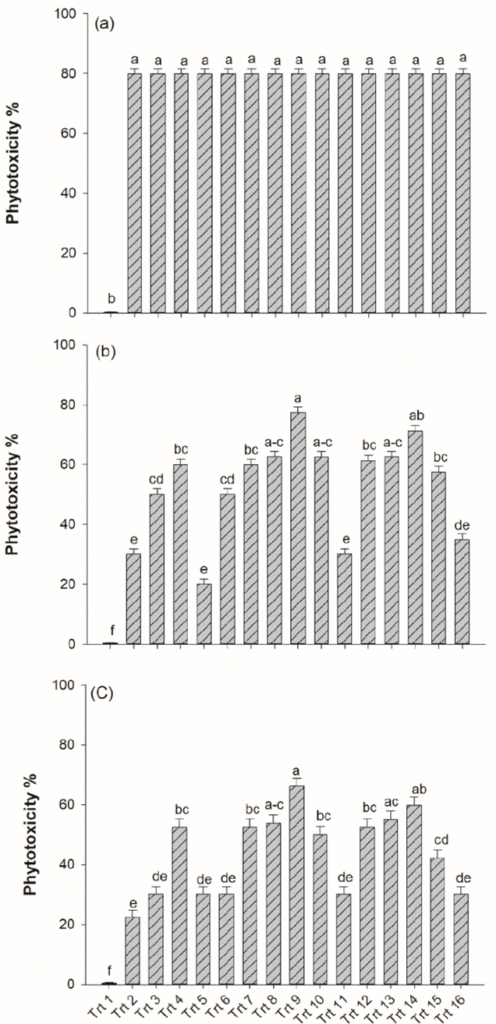



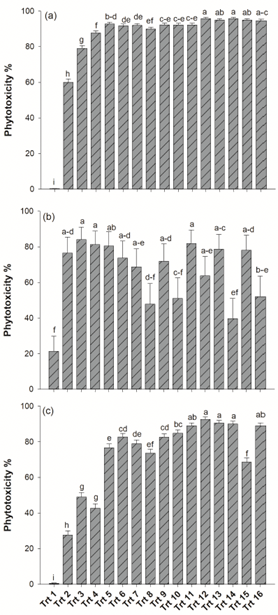

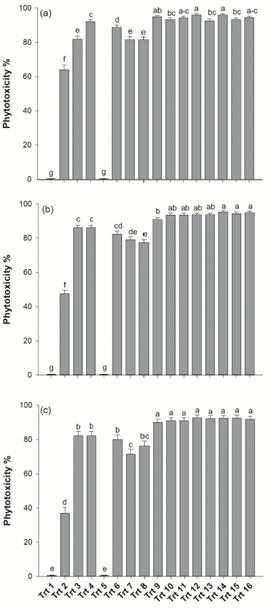
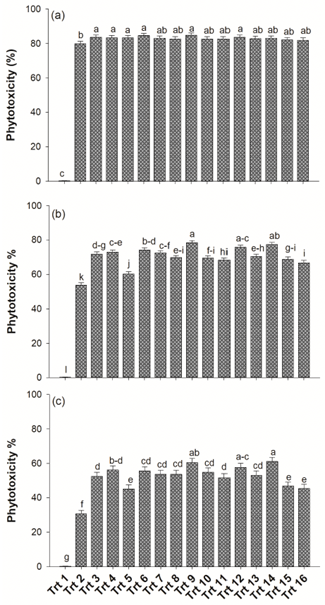
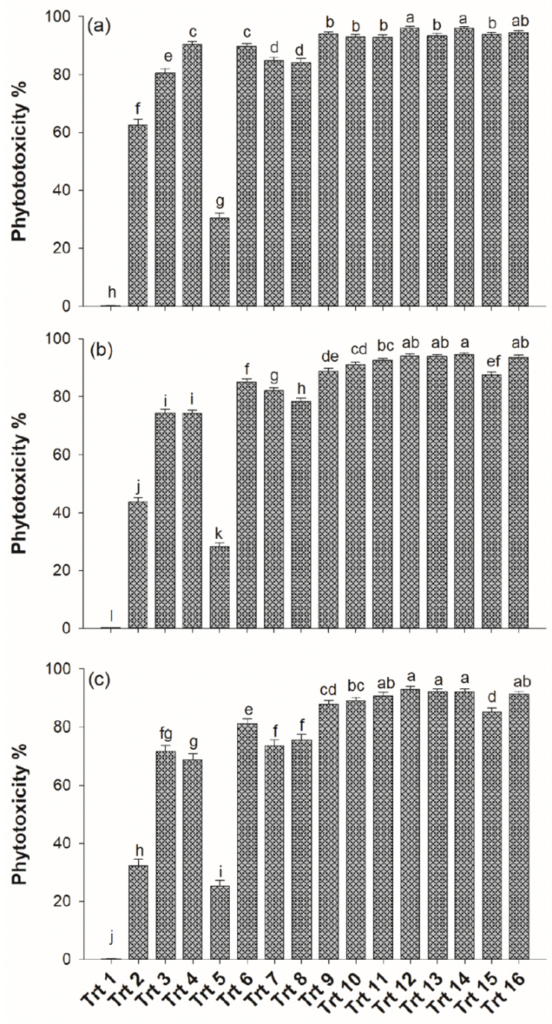


Yields
Herbicide treatment had a significant impact on crop yield (Figure 15). Treatment 1 (Solo®) had the lowest yield, at 2590 kg ha-1 (38.5 bu ac-1), followed by treatments 2 (Sp-Gly) and 3 (Sp-Gly+Ht). There was no significant difference for yield between treatments 5 to 16. Treatment 10 (Sp- Foc+Gly) had the highest numerical yield at 3024 kg ha-1 (45.0 bu ac-1), 16% above treatment 1.
Conclusions and Recommendations
Weed control is a main management concern for Saskatchewan lentil growers, and this project demonstrated several solutions for achieving good control of wild mustard, kochia, and volunteer canola. This research also exhibited the ineffectiveness of some commonly used weed control strategies. The use of spring applied pre-seed burn off and in-crop herbicides alone were not effective regimes for weed control, as Solo® in-crop alone (treatment 1), spring applied glyphosate (treatment 2), spring applied glyphosate + Heat LQ® (treatment 3), and Spring applied glyphosate + Goldwing® (treatment 4) were the least effective treatments for controlling all three focus weed species.
From the results, wild mustard was best controlled by fall applied Focus® with spring applied Heat LQ® + glyphosate (treatment 9) as well as fall applied Fierce® and spring applied glyphosate + Goldwing® (treatment 14).
For kochia control, fall applied Valtera™ and spring applied glyphosate (treatment 11), fall applied Fierce® and spring applied glyphosate (treatment 13), and fall applied Fierce® and spring applied glyphosate + Goldwing® (treatment 14) were the most effective.
Volunteer canola control was highest with fall applied Valtera™ and spring applied glyphosate (treatment 11), fall applied Valtera™ and spring applied glyphosate + Goldwing® (treatment 12), and fall applied Fierce® and spring applied glyphosate + Goldwing® (treatment 14).
Fall applied Fierce® and spring applied glyphosate + Goldwing® (treatment 14) had activity on all three driver weeds as well as high phytotoxicity to the other weeds present, indicating a fall application of flumioxazin (group 14) and pyroxasulfone (group 15) followed by a spring application of glyphosate (group 9) mixed with pyraflufen-ethyl (group 14) and MCPA (group 4) will have a high likelihood of controlling all three weeds. As well, the yield from treatment 14 was 2902 kg ha-1 (43.1 bu ac-1), 12% higher than the control. This treatment was effective at all three stages of assessment indicating that the residual components of the treatment provided season long weed control.
While fall applied Fierce® and spring applied glyphosate with Goldwing® had the most consistent control of weeds assessed, treatments 9 to 16 provided good weed control and resulted in similar yields. These treatments included a residual herbicide and spring burn- off indicating that weed control strategies involving soil residual and preburn herbicides should provide good weed control while maintaining yield. From these results, the main recommendation from this study is the use of herbicide layering and multiple modes of action for improved weed control and lentil yields as well as to prevent development and spread of herbicide resistance.
Acknowledgements
This project was funded by SPG and the Agricultural Demonstration of Practices and Technologies (ADOPT) initiative under the Canada-Saskatchewan Canadian Agricultural Partnership (CAP) bi-lateral agreement between the federal government and the Saskatchewan Ministry of Agriculture. Acknowledgements also go to the staff at the Western Applied Research Corporation in Scott, the University of Saskatchewan research site in Saskatoon, The South East Research Farm in Redvers, and the Wheatland Conservation Area in Swift Current for their technical assistance with project development and implementation for the 2020 growing season.
